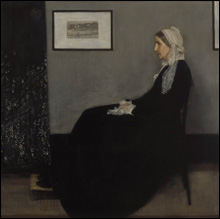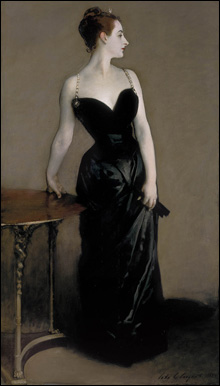What American painters didn’t learn on their European vacations
By GREG COOK | June 21, 2006

ARRANGEMENT IN GREY AND BLACK, #1: PORTRAIT OF THE ARTIST’S MOTHER: An icon that requires reverence, it’s nonetheless as dull as you’d expect. |
Thomas Eakins was one of thousands of ambitious young American artists who flocked to Paris after the Civil War. They went to learn from the great French Académie des Beaux-Arts (the original Academic art) and its official Salons. “What I have learned I could not have learned at home, for beginning Paris is the best place,” the 25-year-old Eakins wrote home to his father in 1869.But they arrived just as the Academy’s pre-eminence was being undermined by Édouard Manet and the Impressionists. They witnessed the birth of European Modernism, but most were too square to realize it. The more than 100 works by 37 artists in the Museum of Fine Arts’ new blockbuster, “Americans in Paris: 1860–1900,” offers some great and important paintings — John Singer Sargent’s Madame X, James McNeill Whistler’s Mother, a raft of Mary Cassatts. But that missed opportunity is the story underlying this show, which was organized with London’s National Gallery and New York’s Metropolitan Museum of Art.
In the mid 19th century, a rapidly growing Paris became the capital of European art and fashion, attracting artists from Scandinavia, New Zealand, Japan. Americans went to copy at the Louvre and study the rigorous academic ways at Paris’s national art school and private studios, which were considered the finest in the West. Eakins studied with a French academic artist so devoted to visual truth that he nailed a cadaver to a cross to study when painting a Crucifixion. Bouguereau and Cabanel reached cornball heights mixing realism and myth to produce photographic pin-up Venuses absurdly lounging atop waves.

MADAME X: The show mostly tells the story of what American artists didn’t learn. |
Americans hoped to make their names by winning spots among the hundreds of paintings crammed into the annual Salons, the top art marketplace. About a third of the Americans were women. They found entry into schools and freedom from both American and French customs as outsiders in Paris. Many Americans wound up broke, homesick, lonely, and pathetically unable to speak the language. They clustered together, keeping American customs, and, as immigrants often do, annoyed nativist sensibilities.Paris must have seemed an escape during the Civil War. Whistler, among the first to go, studied in Paris in the 1850s and missed the war, but some say his mother joined him in London in 1863 to avoid the conflict. Eakins, who bought his way out of Union service, Winslow Homer, who spent much of the war as a Union combat illustrator for Harper’s Weekly, and Cassatt all arrived in Paris within 18 months of the war’s end. In 1867, future Sargent model Virginie Avegno (Madame X), who’d lost her father (he fought for the Confederacy), left an uncertain post-war Louisiana for Paris, where she met and married the rich French banker Pierre Gautreau. The end of the war freed up American wealth and spawned industrial tycoons. This meant more money for art, and it fostered museums like Boston’s MFA and the Met in New York, both founded in 1870.
 Topics
Topics:
Museum And Gallery
, Culture and Lifestyle, History, Painting, More  , Culture and Lifestyle, History, Painting, Visual Arts, Cultural Institutions and Parks, Museums, Museum of Fine Arts, Art History, Cultural History, Boston's Museum School, Less
, Culture and Lifestyle, History, Painting, Visual Arts, Cultural Institutions and Parks, Museums, Museum of Fine Arts, Art History, Cultural History, Boston's Museum School, Less 